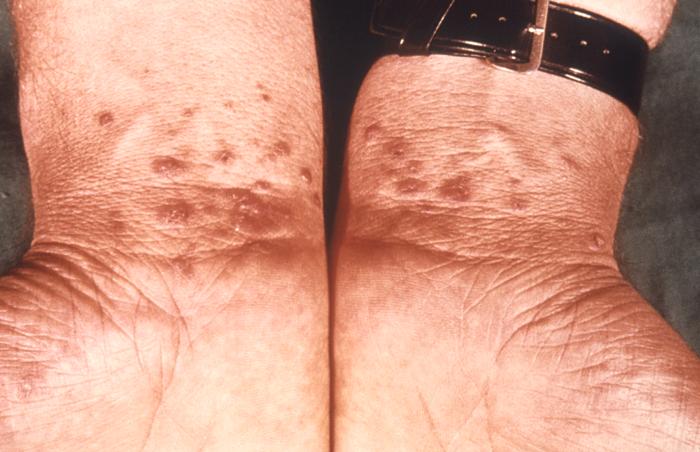Playlist
Show Playlist
Hide Playlist
Lichen Planus: Pathophysiology
-
Reference List Pathology.pdf
-
Slides Lichen Planus Pathophysiology Dermatopathology.pdf
-
Download Lecture Overview
00:01 Welcome. With this talk, we're going to discuss lichen planus. 00:05 Lichen planus is one of those diseases that got named by people who didn't really understand the difference between Greek and Latin. 00:13 Lichen comes from the Greek meaning tree moss, and planus comes from the Latin meaning flat. 00:19 So this is flat tree moss, but it is anything but. 00:24 Lichen planus is a recurrent, pruritic inflammatory rash that's characterized by polygonal, so they've got kind of a shape around them. 00:35 Flat, planus, violaceous purple papules. 00:39 And as we'll talk about, there are six P's associated with lichen planus. So that you can remember this when you see it again. 00:46 The epidemiology. So it affects a little bit less than 1% of the population in the US and around the world, actually. It can occur at any age but is most commonly seen in people in their kind of middle ages, 30 to 60. 01:00 It's extremely rare in children, although it does occur. 01:03 The pathophysiology is largely unknown. 01:07 There are risk factors. 01:08 This is clearly one of those immune dermatosis, a dramatic condition or dermatologic condition that's associated with immune activation. So if that's the case, there's almost certainly a genetic association with certain HLA types, histocompatibility complex molecules. It may also be associated or is associated with hepatitis C virus infections. And this may have something to do with antigens that are generated during that infection that cross-react with various antigens present in certain individuals' skin. 01:42 But again, largely the etiology is unknown. 01:45 There are the risk factors that we do understand certain drugs, and there's a long list of drugs, most of them, interestingly enough, antihypertensives or uh, or antiarrhythmics. And then there are other kind of inflammatory diseases. Systemic inflammatory diseases such as primary biliary cirrhosis, certain infections, the herpes virus type seven in particular. Certain other compounds in the environment, and or radiotherapy have been known to elicit or drive the triggering of a lichen planus. 02:21 All right. This is going to be a fairly complicated figure. 02:25 The complication of the figure just simply means we don't know what the heck is going on. So there is stress not otherwise specified. 02:33 There are drugs or trauma or infections or systemic immune response that cause stress to the keratinocytes, particularly those in the basal layer. 02:43 They release self-antigens that in the appropriate context, that is to say, the right HLA give rise to an autoimmune response in the draining lymph nodes. So we are going to have dendritic cells presenting autoantigens. 02:57 There isn't the normal kind of regulatory T cell environment to keep a immune response from happening, and then we're off and running. 03:06 So those autoantigens get recognized. 03:08 We're generating an autoimmune response. 03:11 When those cells come back around to the skin, then they trigger all the manifestations that we're going to see, including inflammation. 03:21 We're going to see changes in the vascular supply. That's why they're kind of red purple in color. We're going to see that there is increased keratinocyte proliferation and injury. 03:32 So all those things are happening as a result of an autoimmune T cell for the most part driven response.
About the Lecture
The lecture Lichen Planus: Pathophysiology by Richard Mitchell, MD, PhD is from the course Inflammatory Lesions of the Skin.
Included Quiz Questions
Which age group is most commonly affected by lichen planus?
- 30-60 years old
- Under 18 years old
- Over 70 years old
- 18-25 years old
- 65-85 years old
Which viral infection is most strongly associated with lichen planus?
- Hepatitis C virus
- Herpes simplex virus
- Epstein-Barr virus
- Human papillomavirus
- Cytomegalovirus
Customer reviews
5,0 of 5 stars
| 5 Stars |
|
5 |
| 4 Stars |
|
0 |
| 3 Stars |
|
0 |
| 2 Stars |
|
0 |
| 1 Star |
|
0 |




